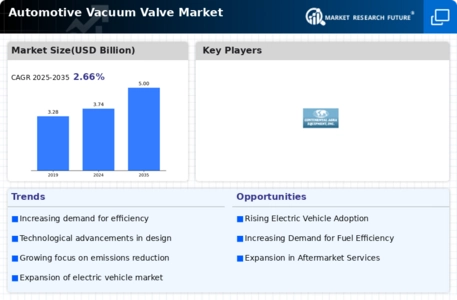Growing Demand for Fuel Efficiency
The Global Automotive Vacuum Valve Market Industry experiences a growing demand for fuel-efficient vehicles, driven by increasing environmental regulations and consumer preferences for sustainability. Automakers are integrating advanced vacuum valves to optimize engine performance and reduce emissions, aligning with global initiatives to lower carbon footprints. This trend is reflected in the projected market size of 3.74 USD Billion in 2024, indicating a robust response to these demands. As manufacturers innovate to meet stringent fuel economy standards, the adoption of vacuum valves is expected to rise, enhancing overall vehicle efficiency and performance.
Rising Production of Electric Vehicles
The rise in electric vehicle production is reshaping the Global Automotive Vacuum Valve Market Industry, as manufacturers adapt to new technologies and consumer preferences. Although electric vehicles primarily rely on electric systems, the integration of vacuum valves in hybrid models remains crucial for optimizing performance and emissions. The increasing focus on sustainable transportation solutions suggests that vacuum valves will continue to play a role in the evolving automotive landscape. As the market transitions towards a projected CAGR of 2.67% from 2025 to 2035, the demand for vacuum valves in hybrid and conventional vehicles is expected to persist.
Regulatory Compliance and Emission Standards
Regulatory compliance and stringent emission standards are pivotal drivers of the Global Automotive Vacuum Valve Market Industry. Governments worldwide are implementing regulations to curb vehicular emissions, compelling manufacturers to adopt advanced technologies, including vacuum valves, to meet these requirements. The necessity for compliance is evident as automakers strive to enhance engine efficiency and reduce pollutants. This regulatory landscape not only influences product development but also shapes market dynamics, as companies invest in innovative solutions to align with evolving standards. The anticipated growth in market size underscores the importance of these compliance measures.
Technological Advancements in Automotive Systems
Technological advancements significantly influence the Global Automotive Vacuum Valve Market Industry, as innovations in automotive systems lead to enhanced functionality and reliability. The integration of electronic control units with vacuum valves allows for precise management of engine parameters, improving performance and reducing emissions. This trend is likely to drive market growth, as vehicles equipped with advanced vacuum systems are increasingly favored by consumers. The market is projected to reach 5.0 USD Billion by 2035, reflecting the industry's commitment to adopting cutting-edge technologies that enhance vehicle efficiency and compliance with regulatory standards.
Expansion of Automotive Manufacturing in Emerging Markets
The expansion of automotive manufacturing in emerging markets significantly impacts the Global Automotive Vacuum Valve Market Industry. Countries such as India and Brazil are witnessing a surge in vehicle production, driven by rising disposable incomes and urbanization. This growth creates a demand for vacuum valves as manufacturers seek to enhance vehicle performance and meet consumer expectations. As these markets develop, the need for efficient automotive components becomes increasingly critical. The projected growth trajectory of the market indicates that emerging economies will play a vital role in shaping the future landscape of the automotive vacuum valve sector.













Leave a Comment